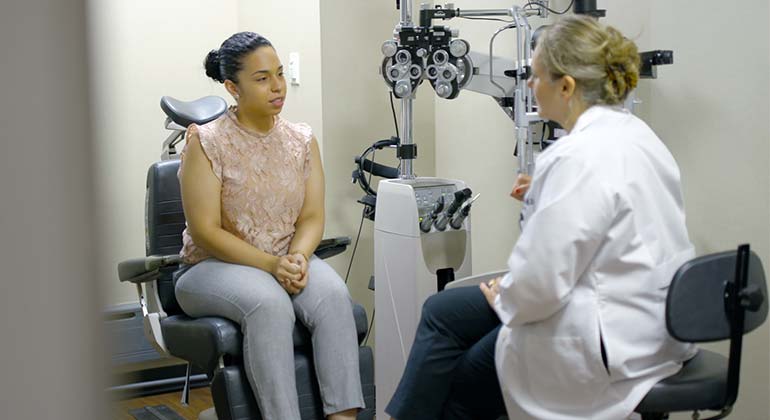The Advantages And Disadvantages of Different Refractive Surgeries for Boosted Eyecare

LASIK Surgical Treatment
LASIK surgery is a typically carried out refractive treatment that aims to fix vision problems such as astigmatism, farsightedness, and nearsightedness. During the procedure, a slim flap is created on the cornea, and a laser is made use of to improve the underlying cells, dealing with the refractive mistake.
One of the key benefits of LASIK surgical procedure is the rapid improvement in vision experienced by lots of individuals. It is necessary for individuals taking into consideration LASIK surgical procedure to undertake a comprehensive examination by an eye care expert to identify if they are suitable candidates for the treatment.
PRK Treatment
The PRK procedure, also recognized as Photorefractive Keratectomy, is a type of refractive surgery that aims to correct vision issues comparable to LASIK surgery. Unlike LASIK, which entails creating a flap in the cornea, PRK works on the surface area layer of the cornea.
Among the benefits of PRK over LASIK is that it eliminates the threat of flap-related complications considering that no flap is developed throughout the surgery. This can be valuable for individuals with slim corneas or those associated with get in touch with sporting activities where eye trauma is a possibility. Nonetheless, the recovery time for PRK is normally much longer contrasted to LASIK, as the outer layer of the cornea needs time to regrow after the procedure. Regardless of the longer recuperation duration, PRK can be a suitable choice for individuals looking for vision correction surgical procedure.
SMILE Surgical Procedure
A sophisticated refractive surgical procedure strategy getting appeal in the area of ophthalmology is SMILE Surgical treatment. Little Incision Lenticule Extraction (SMILE) is a minimally intrusive procedure that corrects vision by improving the cornea utilizing a femtosecond laser. Unlike conventional LASIK surgical procedure, SMILE Surgery includes producing a tiny laceration in the cornea to draw out a lenticule, which leads to less disturbance to the corneal structure and possibly faster recovery times.
One of the primary benefits of SMILE Surgery is its capacity to deal with nearsightedness (nearsightedness) and astigmatism with high accuracy, causing exceptional visual outcomes for people. The minimally intrusive nature of the procedure likewise reduces the danger of complications such as dry eye syndrome, making it a beneficial choice for individuals looking for refractive surgical procedure.

LASEK Technique
Having explored the benefits and factors to consider of SMILE Surgical procedure, one more significant refractive surgery technique worth taking a look at is the LASEK Method. LASEK, which represents Laser-Assisted Subepithelial Keratectomy, is directory a type of laser eye surgical procedure that aims to fix refractive mistakes such as nearsightedness (nearsightedness), hyperopia (farsightedness), and astigmatism.
Unlike LASIK, LASEK does not involve developing a corneal flap. Rather, throughout a LASEK treatment, the surgeon makes use of a watered down alcohol solution to loosen up the thin external layer of the cornea, known as the epithelium.
One of the key benefits of LASEK is that it can be ideal for individuals with thin corneas that may not be good prospects for LASIK. Furthermore, LASEK typically leads to marginal post-operative discomfort and a quicker recovery time compared to PRK. Nonetheless, the visual recovery process with LASEK might be somewhat longer than with LASIK.
Implantable Contact Lenses
Implantable Contact Lenses use a lasting vision correction solution for individuals looking for an alternative to conventional call lenses or glasses. These lenses, also referred to as phakic intraocular lenses, are surgically placed into the eye to fix refractive mistakes such as myopia (nearsightedness), hyperopia (farsightedness), and astigmatism. andalusia pediatrics. Unlike typical get in touch with lenses that sit on the surface of the eye, implantable contact lenses function within the eye itself, offering clear vision without the requirement for day-to-day maintenance or elimination
One of the key advantages of implantable contact lenses is their permanence. As soon as inserted, they can stay in the eye indefinitely, supplying regular and secure vision correction. In addition, these lenses can be a superb alternative for people that are bad candidates for laser eye surgical procedure or who prefer address a reversible vision adjustment procedure.
However, implantable call lenses do lug some threats, consisting of the possibility for cataracts or boosted eye stress. It is important for people considering this option to consult with an eye care expert to determine if implantable get in touch with lenses are the appropriate selection for their certain needs and eye health and wellness.
Final Thought
Finally, each type of refractive surgical treatment has its own advantages and downsides. LASIK surgery is preferred for its quick recovery time, while PRK procedure may be ideal for clients with slim corneas. SMILE surgery supplies minimal discomfort throughout the procedure, yet LASEK technique might have a longer healing process. Implantable get in touch with lenses give a choice for those who are not suitable prospects for conventional surgical treatments. Individuals ought to consult with their eye treatment supplier to determine the ideal option for their individual needs.

On The Whole, SMILE i thought about this Surgery provides a promising alternative for people looking to enhance their vision through refractive surgery.